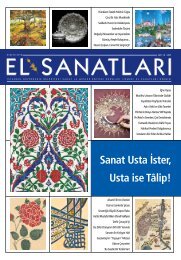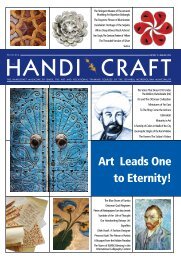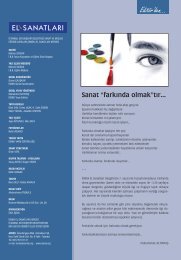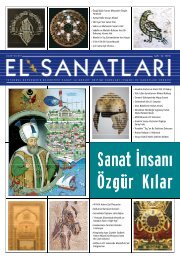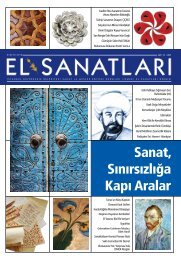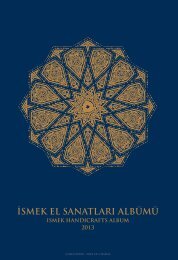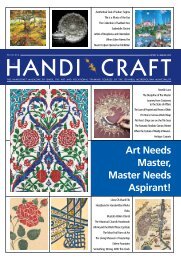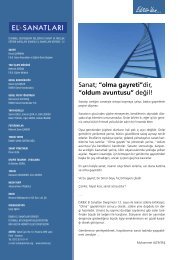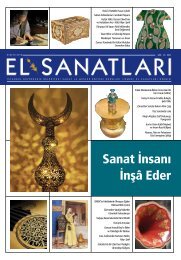Download Link - Ä°SMEK
Download Link - Ä°SMEK
Download Link - Ä°SMEK
You also want an ePaper? Increase the reach of your titles
YUMPU automatically turns print PDFs into web optimized ePapers that Google loves.
Uskudar From the Past to the Present<br />
Having been called Dersaadet, (the door to happiness) Istanbul<br />
was divided into 4 administrative districts until the middle of 19 th<br />
century. One of these districts was Suriçi, a district which was<br />
governed by the judge of Istanbul, and which was considered<br />
to be the centre of the entire metropole. Galata, Uskudar and<br />
Eyup, all of which together are called “Bilâd-ı Selâse”, were the<br />
counties of this large district. Among all these counties which<br />
were governed by judges, Uskudar, beyond doubt, is the most<br />
important one when it comes to representing the Anatolianness,<br />
as well as the Muslim Turk identity.<br />
Uskudar, which represents the Anatolian identity, as well as the<br />
Islamic Turkish traditions, is located at the Asian entrence of the<br />
Bosphorus. After being conquered by Orhan Gazi in 1352, she<br />
began to welcome the Muslim population from the other parts<br />
of Anatolia. Having begun spreading inwards from the coastline<br />
from then on, Uskudar gained her historical identity long before<br />
the conquest of Istanbul. The historical Uskudar used to be<br />
located between Salacak and Paşalimanı. Over the time, however,<br />
she has grown and spread, like all the counties of Istanbul.<br />
Suffice it here to say, in my opinion, in order to emphasize the<br />
importance of Uskudar for both Istanbul and the history, that in<br />
addition to the Mihrimah Sultan Mosque, which was built after<br />
the name of Suleyman the Magnificent’s daughter Mihrimah<br />
Sultan, the Master architect Mimar Sinan built 34 other glorious<br />
structures in this beautiful county, beginning from 1547. No<br />
other county in Istanbul has so many Works built by this great<br />
Architect. 1<br />
The Architectural Characteristics Of The Ahmediye<br />
College And Its Auxiliary Buildings<br />
One of the important structures which were built by Mimar<br />
Sinan in the light of the architectural characteristics of the<br />
Tulip Era (1703-1730), is the Ahmediye College, which has<br />
preserved its architectural identity up to day. This historical<br />
college is located in the Ahmediye district of Uskudar, on<br />
Gundoğumu Avenue, (The Ahmediye Avenue by the old<br />
name) on the corner which connects the avenue to Esvapçı<br />
Street, and it has 2 yard Gates leading both to the avenue,<br />
and to the street. Due to the slope, the hewn Stone gate on<br />
the street which doesn’t have epigraph opens to a starecase<br />
that leads to the yard. Being an arched marble gate embroidered<br />
with relief flowers and lacework, however, the gate<br />
on Gundoğumu Avenue is a work of art in and of itself. The<br />
aforementioned rare and precious flower reliefs which can<br />
be observed quite frequently on the Works made during the<br />
Tulip Era, and the more beautiful samples of which we can<br />
see on the Square fountain of Ahmet the 3rd in Uskudar,<br />
fascinate the visitors, preparing them to discover this masterpiece.<br />
This work of art is a momento of the Tulip Era gifted<br />
to Uskudar with its relief flower embroideries, laced archs,<br />
roselike flower motives and relief cypresses, in short, with the<br />
most glorious examples of the Turkish art in the 18 th century.<br />
It consists of a mosque, a madrasah, a library, a water serving<br />
building and 2 fountains. Owing to its location, it also has a<br />
great importance in contributing to determine the city structure,<br />
which is another feature that makes it special. Located<br />
on a route which was considered important until the first half<br />
of the 18 th century, the Ahmediye District begins from the<br />
Uskudar Pier, located on a route that connects the bazar road<br />
to the tomb of Karacaahmet, (an important religious figure<br />
in Islam), and the Ibrahimağa Road to the old Bagdad Road.<br />
The burial area in the Ahmediye Mosque<br />
The Architectural Plan Of The College Is As Follows:<br />
2 separate gates are used to enter the complex whose premises<br />
have been placed in 2 rows, one being on the street side, and<br />
the other on the avenue side. The main gate, which is also called<br />
the lodge gate or the classroom gate, is located on Gundoğumu<br />
Avenue, with a fountain to its right, and a water serving building<br />
to its left. Above the gate is mounted the classroom of the Madrasah,<br />
which was built by Ahmet Ağa, the navy yard fiduciary<br />
in 1720-21 (1133 by the Muslim Calendar). The window of the<br />
classroom under which are archs, as well as the surrounding wall<br />
of the fenced burial place whose fences are weaved of Bronze<br />
wires, continue downwards. In addition, another fountain<br />
made of white marble, which doesn’t have epigraphs, is placed<br />
in front of the yard wall that is close to the corner where the<br />
fenced burial place ends. Behind this fountain is another fenced<br />
burial place that belongs to the college. The library building lead<br />
by the second gate which doesn’t have epigraphs, is built on a<br />
raised ground flor and is the northern side of the college, which<br />
is also on Esvapçı Street. The Southern and Western ends of the<br />
yard that can be reached by using both Gates, are surrounded<br />
by the madrasah rooms, forming an L. The place for the person<br />
who determines the prayer times, the hamam (Turkish bath) the<br />
kitchen, the dining hall and an open mausoleum, which are the<br />
other auxiliary buildings attached to the college, are quite noteworthy.<br />
In addition, the charity Stone, which is placed in front of<br />
the burial place wall, to the left of the place alotted to the prayer<br />
time determiner, is also a valuable historical document that completes<br />
the college. 2 Considering ıts ornament characteristics, one<br />
can assume that the college has greatly preserved the motives<br />
from the stonework style used during the Tulip Era.<br />
The accounts given in the Sicill-i Osmânî (the Ottoman records)<br />
about the Fiduciary Ahmed Ağa, who is the builder of the college,<br />
are as follows: Being the brother of Ali Pahsa of Izmir, Fidu-<br />
155



